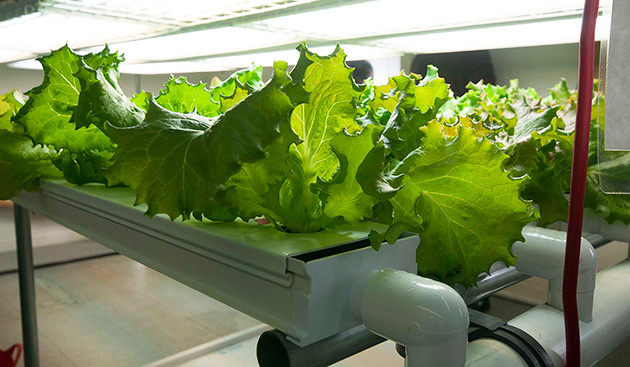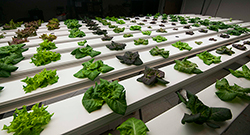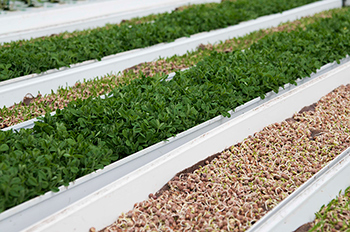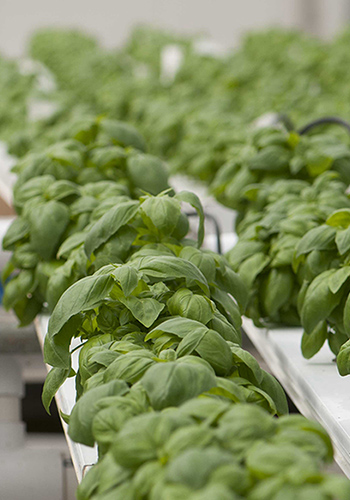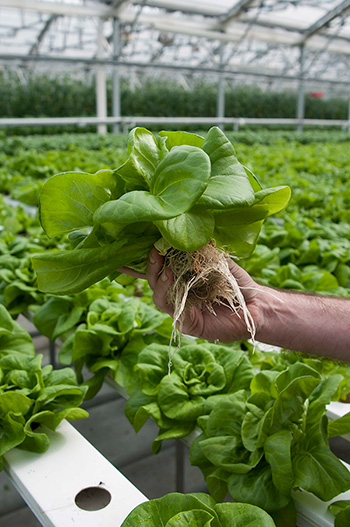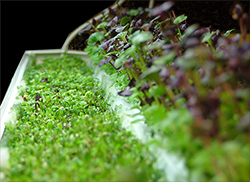- Introduction to Hydroponic Growing | Article | Johnny's Selected Seeds
- Introductory Hydroponics Information Guide | Printable 4-pp Brochure (PDF)
- How to Grow Healthy Hydroponic Seedlings | Seed-Starting & Environmental Variables
- Hydroponic Seed-Starting & Environmental Variables | Tech Sheet (PDF)
- Hydroponic Grow Media | 10 Common Types, Care & Additional Considerations
- Hydroponic Growing Media | Tech Sheet (PDF)
- Pest & Disease Control Basics in Greenhouse, Hydroponic & Other Protected-Culture Systems
- Pests & Diseases of Greenhouses & Hydroponic Systems | Tech Sheet (PDF)
- Hydroponic & Container Basil Guide | Production Advice & Variety Recommendations
- Hydroponic & Container Basil Guide | Printable 4-pp Brochure (PDF)
- Digital Hydroponic Head Lettuce Catalog | Johnny’s Selected Seeds
Introduction to Hydroponics
The term hydroponics refers to the practice of growing crops without soil. In contrast to soil-based agriculture, where the plants feed by extracting nutrients from the soil, the roots of hydroponically grown plants are bathed in a complete liquid plant food that contains the essential nutrients.
In place of soil, some hydro systems employ a soilless medium such as rockwool, coconut fibers (coir), or clay pellets to anchor the plants. Other systems contain no solid growing medium, with the roots bathing directly in the liquid. The common thread tying all hydro systems together is that the plants are receiving fertility from the nutrient solution, rather than soil.
Most hydroponic systems are housed under cover, primarily in greenhouses, to allow maximum control over the growing environment. Without the absorptive and buffering effects of soil, any precipitation that falls on an uncovered system would alter the nutrient solution conductivity, throwing the system off balance. Of the hydro systems that are set up outdoors, most are located in arid parts of the world.
Hydroponic systems can be located almost anywhere, including otherwise underused spaces such as vacant lots and rooftops, and areas lacking arable land or an ample water supply. Installations can be scaled to footprints ranging anywhere from hundreds of acres down to inches, or configured vertically, depending on grower needs. Hydroponic culture helps growers avert weeds, soilborne disease, and fertility problems by bypassing soil altogether.
1 • Types of Hydroponics Systems
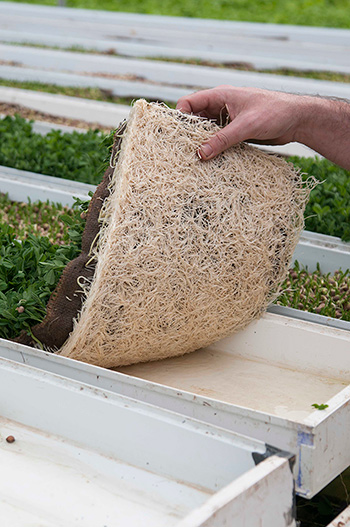
Hydroponic Seed-Starting for Healthy Hydroponic Seedlings • How to Begin, What to Monitor & Why • Article
• Tech Sheet (PDF version)
For an overview of common growing media options; how plugs differ from soilless mix in hydroponic production; monitoring salt buildup in different types of media; and maintaining medium hygiene, see:
Choosing Your Hydroponic Grow Medium • A Review of Common Types • Article
• Tech Sheet (PDF version)
Between commercially manufactured and homemade hydroponic systems, the equipment can be configured in many different ways, but most hydro systems used to grow food crops fall into two main camps: those that do include a solid growing medium (also known as substrate hydro systems) in place of soil, and those that do not (also known as liquid hydro systems).
Regardless of the type of hydroponic system, seeds are usually sown in soilless plugs or mats designed to secure the growing plant for the entire cropping cycle. The seeds of long-season fruiting crops are usually sown into small plugs that fit into a larger block, usually a 4" (10cm) cube, to allow the seedling to grow larger before being transplanted into the production greenhouse.
Shorter-cycle crops, such as lettuce and greens, are usually transplanted into the growing system in their original plug without being potted-on to the larger block. The most common materials used for propagation plugs, blocks, and mats are coir, rockwool, or inert foam, such as Oasis cubes.
SUBSTRATE-FREE / LIQUID HYDRO SYSTEMS (NO SOLID MEDIUM)
Hydroponic systems where the roots bathe directly in nutrient solution, without any type of solid soil substitute securing the plants, are known as liquid hydro systems. There are many ways to design a liquid hydro system; these are the 3 basic types:
- Nutrient Film Technique (NFT)
The most common hydroponic system used today, NFT systems use long gutters or troughs to hold the plants as they grow. Typically, there is a cover lying overtop the gutter, with holes in which the plants are nested. The roots grow in the gutters without any medium other than a small plug securing the plant in place. Nutrient solution is piped in at the top of the gutter, flows down, and drains at the bottom of the channel. The nutrient film refers to the thin layer of nutrient solution present in the channel where the roots grow. An air pump and air stone are often used to aerate the nutrient solution and increase the supply of oxygen to the roots.
- Deep-Water Culture (DWC)
Deep water culture involves growing crops in standing nutrient solution, with their roots dangling in the solution. Instead of channels, crops grow in tubs or basins, with the plants commonly anchored in floating rafts, with no medium other than the plugs securing the plants in place. Because the roots are submerged, it's critical to provide them with oxygen, typically by means of an air pump and air stone within the reservoir.
- Aeroponics
Aeroponic hardware designs vary widely, but in all aeroponic systems the crops are held suspended in air and irrigated with a nutrient vapor mist, sprayed at regular intervals. Primary benefits are the greater levels of oxygen available to the roots and significantly less weight in the system. Although less common in the past than the other two main types of liquid hydro systems, aeroponics systems are rapidly becoming a focus of research and development in lean-input crop production.
SOLID MEDIUM / SUBSTRATE SYSTEMS
Hydro systems that include growing media can be divided broadly into container culture and slab culture. The medium holding the plant in hydro systems can be composed of a wide range of materials, including rockwool, coir, hemp, sand, perlite, sawdust, wood chips, or others.
- Container Culture
Container culture refers to the use of containers to hold the soilless aggregate medium in which the plants grow. The containers can be anything from buckets, pots, or grow-bags specifically manufactured to hold plants, to repurposed bags, buckets, or other alternatives.
- Slab Culture
In slab culture, plants are grown in long, flat slabs of media that are made specifically for this application. Commonly available materials for slabs include rockwool and coco coir. Slab dimensions vary by crop and conditions but typically measure a couple inches in depth by a foot or so in width by a few feet in length. Each slab is designed to house multiple plants growing from its top surface, with the number of plants depending on the type of crop. Slabs are usually wrapped in plastic or biodegradable film, to contain the nutrient solution. Individual slabs are laid end-to-end to form a row.
One big difference between liquid and substrate hydroponic systems is that substrate systems usually require one emitter per plant, to deliver the nutrient solution to the roots. This is in contrast to liquid hydroponics, where the nutrient solution is contained in the root zone by the channel or the basin, depending on the system.
AQUAPONICS
This methodology involves growing crops with the recycled nutrient waste from aquaculture. The nutrient solution is derived directly from water used to raise fish or other aquatic animals. The nutrients in the waste from the animals are used to feed the crops, creating an efficient food production system. Aquaponic systems can be integrated with any of the above hydro systems. The aquaculture waste is the source of fertility, and the hydro system of choice, whether NFT, DWC, or otherwise, is the method of delivery.
2 • The Growing Differences : Hydro vs. Soil
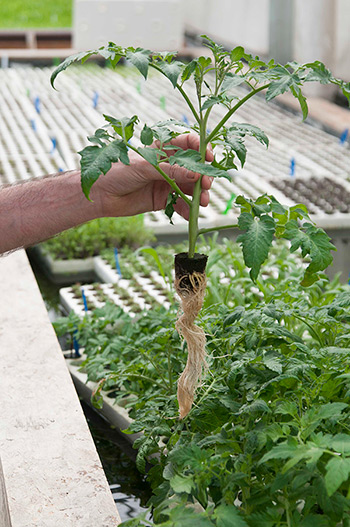
CONCERTED MANAGEMENT
As with any other engineered system, hydroponic growing only works as well as the system is designed and managed. Unlike some field crops that can grow with little attention for extended periods of time, hydroponic systems require management on a daily basis. Hydro crops are not typically "watered" but rather uptake water and fertility through a nutrient solution provided on a continual or as-needed basis via a circulating system. With their smaller root volumes and lower buffering capacity than soil-grown crops, hydroponically grown crops are prone to more rapid and drastic consequences when a pump or timer fails or a nutrient solution goes out of balance.
FERTILITY PROGRAMS
Hydro system fertility requirements also vary widely on the basis of crop, growing environment, regional and seasonal factors. Success of the crop is dependent on providing a nutrient solution that matches all of these factors. Beginning hydro growers are encouraged to use a complete fertility program that has been designed by the manufacturer with their circumstances in mind. Once they gain familiarity with how the crops should perform, more experienced growers can blend their own custom fertilizers from single elements on their own.
3 • Benefits of Hydroponic Growing
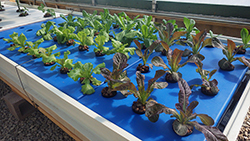
“ We had our produce randomly tested by the public health authorities, and they came back to us with great results. Clean produce, inside and outside. ”
— Penny Takahashi, Aquaculture Centre of Excellence, Lethbridge College, Alberta, Canada
Image courtesy of Aquaculture Centre of Excellence, Lethbridge College. All rights reserved.
What are some primary benefits of growing hydroponically? From a grower's standpoint, efficiency, yield, and quality come first to mind — though in the long-term, sustainability could be the primary underlying advantage for all of us. The following are some key points supporting the case for hydroponic growing.
YEAR-ROUND PRODUCTION & YIELD
Growing indoors or in a greenhouse can allow growers to better optimize the environment, making year-round growing a more viable option. More growing cycles means more yield. Yield for some crops can also be significantly higher compared to those grown in soil because the roots are well aerated in hydroponic systems; because there are ample nutrients in an readily accessible form (if the hydro grower is optimizing the nutrients in solution); and because plants can be spaced more densely when there is less competition for nutrients.
SUSTAINABILITY
Wherever limitations exist in water use or arable farmland, this aspect of hydroponics increases in relevance. Much of the benefit gained from hydroponics derives from the fact that in most systems, the water-based nutrient solution is reclaimed and recycled. Growers can calculate exactly how much water is needed in their systems, providing growers in areas that lack sufficient water the opportunity to make the best use of water resources. In areas where water use and quality are closely regulated, hydroponic systems allow growers to track volume, precisely measure nutrient flush levels, and meet specific requirements.
URBAN GROWING/LOCAL FOOD
As consumers increasingly seek locally-sourced food, hydroponics can help satisfy this demand. As mentioned, hydroponics systems can be set up even where good farmland does not exist. Urban farms are popping up across the country and in cities around the globe, supplying metropolitan regions with food grown directly within the city. Hydroponic growing also provides educators, chefs, families, and restaurateurs with an opportunity to produce their own crops — on a rooftop, in a parking lot, in a warehouse, or on the back patio — limited only by ingenuity and determination.
PESTICIDE INPUTS MINIMAL TO NIL
A well-managed hydroponic operation will be under minimal disease pressure, and most hydroponic growers find they need to use minimal — if any — pesticides. Many growers sell their product as spray-free, which helps to satisfy the need for healthy, pesticide-free food. Given proper management, pesticide use can be reduced and often entirely eliminated.
ERGONOMICS
Depending on the type of system used and how well it is designed, hydroponic production can be more ergonomically sound than standard field production. Systems can be built, for example, so that they are waist-high, or arrayed in vertical towers, making for easier care and harvesting. In other systems, entire plots of plants are being shifted to a specific harvest location to make harvest and postharvest handling easier and more efficient for workers.
POTENTIAL FOR REDUCED LABOR & OTHER RESOURCE INPUTS
An increasing number of power-reducing technologies can be practicably applied to hydroponic operations: LED lighting for inside and geothermal power for bigger, outdoor facilities, for example. As distinct from traditional soil growing, there is no need for tilling, plowing, or weeding in hydroponics systems. Aquaponic systems, in particular, require little to no fertilizer input, as the waste of the live fish grown in tanks can be converted into the nitrogen-rich food the plants need, and the plants in turn can be used to clean the water for recycling back to the fish tanks. And by virtue of their ability to be installed proximal to a market, there may be fewer transportation costs involved in producing food in hydroponic systems, thereby helping to reduce its carbon footprint.
Whether a grower's everyday values include environmental, fiscal, or social responsibility, hydroponics offers some major practical advantages.
4 • Planting Programs: Scheduling What to Plant & When
While hydroponic production can follow much the same seasonal cycles as soil-based culture, conditions within the hydroponic setting are more amenable to tight control, allowing for intensive management protocols to maximize ROI. In areas with cold winters and moderate summers, fruiting crops can be started in the winter or early spring and terminated the following fall or winter. In areas with summers that are prohibitively hot for growing, the opposite crop schedule is often used. Seedlings are started in the summer, transplanted into the greenhouse after the hottest weather has passed, and grown through the winter to be terminated the following year before the hottest weather returns.
Lettuce, greens, herbs, microgreens, and shoots can be scheduled for as many short production cycles as the growing environment permits. Varieties may need to be modified with the changing seasons to allow year-round production of any given crop.
5 • Specialty Hydroponic Techniques: Multiseeding & Living Harvests of Lettuce, Greens & Herbs
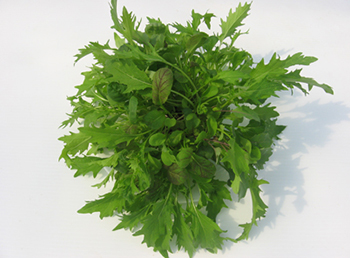
The "living harvest" concept is one to which hydroponics is especially well-suited. Since plants can be quickly and efficiently removed from the system with their roots intact, growers are harvesting lettuce, greens, and herbs by pulling them from the system for sale as whole plants. The main advantage of this method is the prolonged shelf life, as the damp roots continue to feed the plant. Produce sold in this fashion is usually packaged in clamshells or individually bagged, to protect other produce from contact with the roots and nutrient solution.
One variation on this technique involves planting multiple seeds into a single plug to deliver multiheaded living produce to the customer. For example, two or more seeds of lettuce, basil, and/or greens of contrasting colors can be planted into the same plug, so the customer receives a multicolored "living bunch."
6 • How to Choose Varieties Suited for Hydroponics
Together with excellent flavor and appearance, crops best suited for hydroponics share certain characteristics.
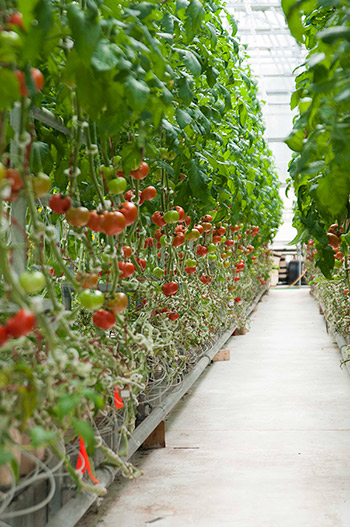
FRUITING CROPS
In fruiting crops, a high level of vigor is important to keep the plants strong over a long season. Resistance to blossom end rot is important in the solanaceous crops, since fast-growing fruits can be susceptible to this disorder. Resistance to diseases common in various growing regions will help keep the plants healthy. Having an open plant habit that promotes air flow can be equally important, as fruiting crops are usually planted densely in greenhouses. For tomatoes, a predictable and trainable plant habit and production pattern are desirable, with well-shaped trusses and good fruit set. Strong central leaders will be less perturbed by heat/cold/light variations that are outside the environmental norm for the species.
LEAFY CROPS
The features that make lettuce, greens, and herbs suitable for hydroponics include resistance to diseases common in the greenhouse for leafy crops, such as root rot diseases, particularly Pythium spp. Strong color expression, too, is a key trait for hydro production of leafies. (Color gets washed out in low light conditions, so you need to choose varieties with deeper pigmentation.) While speed-to-desired-weight is a desirable feature of lettuce, it must be balanced by some degree of tipburn resistance, as rapidly growing greens, particularly lettuces, can be prone to this disorder. Resistance to bolting is another favorable characteristic in hydroponic production systems.
When it comes to form for leafy crops, varieties that are dense and compact will allow you to fit more plants into the allotted space, and compact plants are also less likely to tip over in trough systems. The other important reason hydro growers seek compact and dense plant types is that leaves become thinner, and plants more sprawling/stretched, in hydro systems — which means that dense, compact plants grown in hydro systems are actually of similar size to "standard" plants grown in the field. The development of Salanova and other one-cut lettuces has made it easier to achieve good yields of high-quality salad mix hydroponically, and many smaller growers are achieving success with high-density plantings of these and other leafy greens.
Microgreens and shoots, with their short crop cycles, are well suited to hydroponic culture because they rarely need fertility inputs. They are commonly grown in a modified NFT system, with a piece of burlap, hemp, or other material lining the gutter to secure the roots. The microgreens can then be harvested by cutting the stems to provide loose microgreens, or by cutting the medium to provide a square of rooted, living product.
Microgreens and shoots, with their short crop cycles, are well suited to hydroponic culture because they require minimal fertility inputs. They are commonly grown in a modified NFT system, with a piece of burlap, hemp, or other material lining the gutter to secure the roots. The microgreens can then be harvested by cutting the stems to provide loose microgreens, or by cutting the medium to provide a square of rooted, living product.
Production of smaller quantities can be accomplished using 1020 trays lined with hemp fiber; we now offer 5"x5" hemp mats and corresponding inserts that fit 8 to a 1020 tray for this purpose, so growers can mix, match, and market a selection of smaller quantities to hydroponic customers or for use at their own table.
View our Microgreens Growing Supplies…
View our Microgreens Selection…
POPULAR CROPS
The most popular food crops for hydroponic production are tomatoes, lettuce, cucumbers, greens, peppers, eggplant, strawberries, herbs, microgreens, and shoots. These crops fall into one of two main production models: one long harvest; or multiple quick harvests.
- One Long Harvest. Fruiting crops such as tomatoes, cucumbers, peppers, and eggplant are typically raised for a long season of up to a year, and the same plants are harvested many times for an overall high yield.
- Multiple Quick Harvests. Crops such as lettuce, greens, herbs, and microgreens are significantly quicker-cycle crops, which provide a high overall yield by being planted and harvested many times over the course of a season.
More Resources
SYSTEM CHOICE
Technically, nearly any crop can be grown in any hydro system. Systems that use media, however, such as slab or bucket culture, are most popular for the fruiting crops: tomatoes, cucumbers, peppers, and eggplant. And liquid systems are the most popular for leafy crops such as lettuce, greens, and herbs. NFT systems are the most popular for microgreens and shoots.
Technical Growing Articles/Tech Sheets
Refer to the following articles for additional guidance on hydroponic materials and methods, or download the printable PDF version.
- Hydroponic Seed-Starting for Healthy Hydroponic Seedlings • How to Begin, What to Monitor & Why
An introduction to the basic steps of seed-starting in hydroponic systems and primary environmental variables that affect plant health and productivity in hydroponic systems, with specs for hydroponically grown crops and how they are maintained and monitored, including temperature, light, daily light integral, pH, and carbon dioxide, plus recommended further reading.
• Tech Sheet (PDF version) - Choosing Your Hydroponic Growing Medium • A Review of Common Types
An overview of the more common hydroponic growing media options and how to select the medium best suited to your needs; how using plugs differs from using a soilless mix in hydroponic production; monitoring salt buildup in different types of media; maintaining medium hygiene; and recommended further reading.
• Tech Sheet (PDF version)
SEEDS, PLUGS, EQUIPMENT & SUPPLIES
- Johnny's Hydroponics Performers Product List
As we currently do not have a hydroponic trialing system at our Research Farm, we have aggregated the results of trials of independent hydroponic growers with our own variety knowledge and the information we receive from our suppliers, to compile our Hydroponics Performers category. You can browse and compare all varieties suitable for hydroponic production in this section of our site. - Johnny's Microgreens Supplies • Product List
PRINTABLE BROCHURE & PRODUCT LIST PDFs
- Johnny's Hydroponic Information Guide • Printable 4-pp Brochure (PDF)
This 4-page PDF (2 sheets if printed on both sides) contains most of the information found in this article, in a convenient, printable form. - Johnny's Digital Hydroponic Head Lettuce Catalog • Downloadable/Printable 22-pp Catalog


